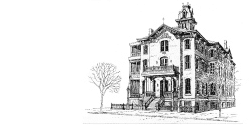Artists and Nature
William Jacob Hays, Sr., The Gathering of the Herds, 1866.
Background Information
When Americans travelled West they were stunned by the extreme landscapes and new wildlife they had not previously seen. Artists were inspired by the natural world around them, and they used art to both connect with and dominate over nature. Certain animals depicted elicited wonder and fear, while others showcased the abundance of resources available in the newly acquired territory.
Look Closer

When the artist made this painting, bison were not common east of the Great Plains. Notice how the artist depicts bison herds in their environment.
Notice how part of the herd forms the left side of the composition,
and another part of the herd comes in from the right.
Take in the background of the painting, and notice how far the herd extends toward the horizon line.
Locate the antelope in the painting, and consider the scale of these animals in their plains environment.
Now, locate the skull, and think about why the artist included this in his composition.
William Jacob Hays, Sr., The Gathering of the Herds, 1866.
When the artist made this painting, bison were not common east of the Great Plains. Notice how the artist depicts bison herds in their environment1. Notice how part of the herd forms the left side of the composition2, and another part of the herd comes in from the right3. Take in the background of the painting, and notice how far the herd extends toward the horizon line4. Locate the antelope in the painting, and consider the scale of these animals in their plains environment5. Now, locate the skull, and think about why the artist included this in his composition6.
Discussion Questions
- What words would you use to describe your experience of this scene? Think about the emotional connections the artist creates with the natural world through the way in which he depicts the scene. What words would you use to describe your experience of the scene?
- How does the artist visually describe the animals to viewers that are unfamiliar with the animal and its territory?
- How do you think this might impact your relationship to this place and these animals?
- Consider your relationship to the scene of bison, as the viewer. What is the viewer’s vantage point?
Activity
Some artists hoped to inspire viewers to have an emotional connection to the lands of the West. In some cases, these artworks helped to preserve the natural wonders of this region, like the establishment of the National Park system. Think of a natural resource, animal, plant, or ecosystem that is threatened in the Western United States today. Do additional research on this resource using the attached worksheet, and make a list of what has made it important throughout history, and why it is necessary to save or conserve. Using this information, create an artwork, infographic, or poster that inspires viewers to preserve it for future generations. You may even be inspired to create a slogan!
Materials:
Sustainability worksheet
Research on environmental sustainability/conservation
Pencils
Colored pencils/crayons/markers/watercolors
Paper
Grade levels: P-12 CO Standards
Visual Arts (2020)
Preschool 1.1 ; 2.1 ; 3.1 ; 4.1
Kindergarten 1.1 ; 2.1 ; 3.1 ; 4.1
1st Grade 1.1 ; 2.1 ; 3.1 ; 4.1
2nd Grade 1.1 ; 2.1 ; 3.1 ; 4.1
3rd Grade 1.1 ; 2.1-2 ; 3.1 ; 4.1
4th Grade 1.1-2 ; 2.1-2 ; 3.1-2 ; 4.1
5th Grade 1.1-2 ; 2.1-2 ; 3.1-2 ; 4.1
6th Grade 1.1-3 ; 2.1-2 ; 3.1-3 ; 4.1-3
7th Grade 1.1-3 ; 2.1-2 ; 3.1-3 ; 4.1-3
8th Grade 1.1-3 ; 2.1-2 ; 3.1-3 ; 4.1-3
High School 1.1-3 ; 2.1-3 ; 3.1-3 ; 4.1-3
Social Studies (2020)
Preschool 1.1 ; 2.1
Kindergarten 1.1-2 ; 2.2
1st Grade 1.1 ; 2.1-2 ; 3.2
2nd Grade 1.1 ; 2.2 ; 3.1 ; 4.1
3rd Grade 1.1 ; 2.1-2 ; 3.1
4th Grade 1.1 ; 2.1-2 ; 3.1 ; 4.1
5th Grade 1.1 ; 2.1-2 ; 3.1
6th Grade 1.1 ; 2.1-2
7th Grade 1.1
8th Grade 1.1-2 ; 2.1-2
High School 1.1- 3; 2.1-3 ; 3.1,4 ; 4.1
Reading, Writing and Communicating (2020)
Preschool 2.1-2 ; 4.1-2
Kindergarten 1.1-2 ; 2.2-3; 3.1-2, 4 ; 4.1
1st Grade 1.1-2 ; 2.2-3 ; 3.1-2, 4 ; 4.1
2nd Grade 1.1-2 ; 2.2-3 ; 3.1-2,4 ; 4.1
3rd Grade 1.1-2 ; 2.2-3 ; 3.1-2,4 ; 4.1
4th Grade 1.1-2 ; 2.2-3 ; 3.1-2, 4 ; 4.1
5th Grade 1.1-2 ; 2.2-3 ; 3.1-2,4 ; 4.1
6th Grade 1.1-2 ; 2.2-3 ; 3.1-2,4 ; 4.1
7th Grade 1.1-2 ; 2.2-3 ; 3.1-2,4 ; 4.1
8th Grade 1.1-2 ; 2.2-3 ; 3.1-2,4 ; 4.1
9th/10th Grade 1.1-2 ; 2.2-3 ; 3.1-2,4 ; 4.1
11th/12th Grade 1.1-2 ; 2.2-3 ; 3.1-2, 4 ; 4.1
Science (2020)
Preschool 1.1 ; 2.1-2 ; 3.1-2
Kindergarten 1.2 ; 2.1 ; 3.2
1st Grade 2.1-2
2nd Grade 2.1-2
3rd Grade 2.1,3
4th Grade 3.3-4
5th Grade 3.3-5
Middle School 2.5-7,9 ; 3.8,10-11
High School 2.4-6,13 ; 3.7-9,11
Resources



